Alibaba processes over 12.7 billion orders annually, making it an excellent platform for Amazon sellers to buy products at low prices and sell them to buyers on Amazon.
Selling Alibaba products on Amazon can be a profitable business for many people around the world. By making use of Alibaba’s wide range of suppliers (almost 8.5 million) and Amazon’s large customer base (279 million), sellers can create successful businesses.
In this guide, we have discussed how to find products, how to sell Alibaba products on Amazon, and how to ship them.
How to Sell Alibaba Products on Amazon?
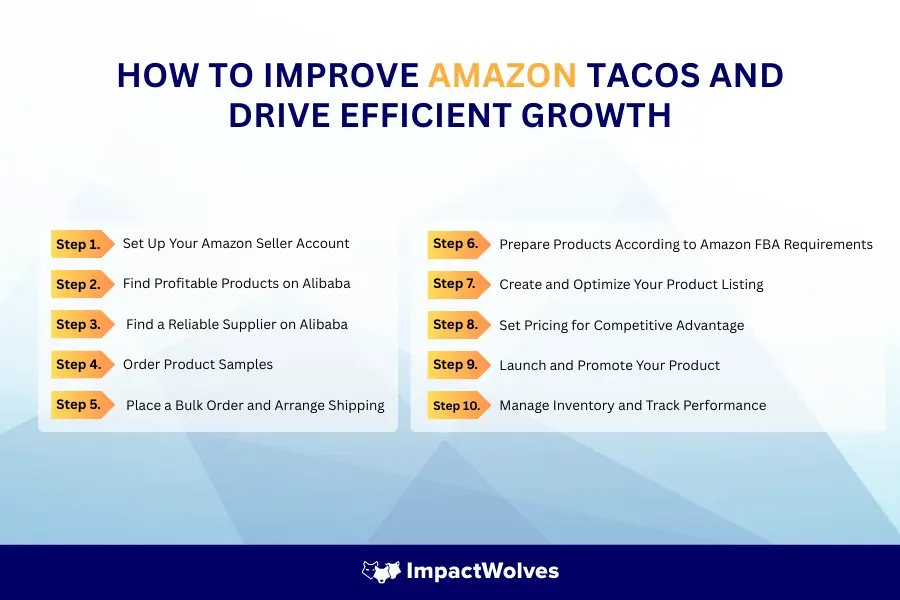
In this section, we’ve laid out the entire process of how to sell on Amazon from Alibaba in easy steps. Let’s have a look:
Step 1: Set Up Your Amazon Seller Account
To start selling on Amazon, you’ll first need to create a seller account:
- Select the Appropriate Selling Plan: Individual (pay-per-sale) or Professional (monthly subscription)

- Business Information: Legal name, address, contact info, and tax details
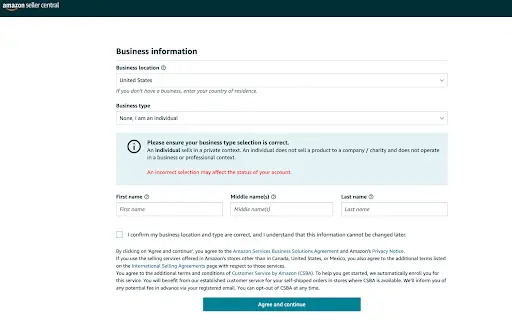
- Set Up Payment Details: Bank account information to be used for receiving payments.
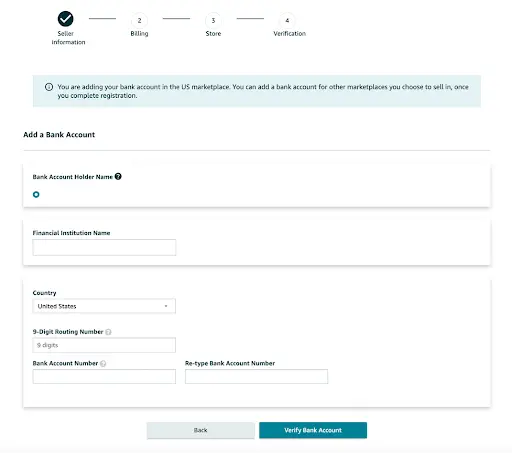
- Identity Verification: You will need to provide specific documents, which will be verified.
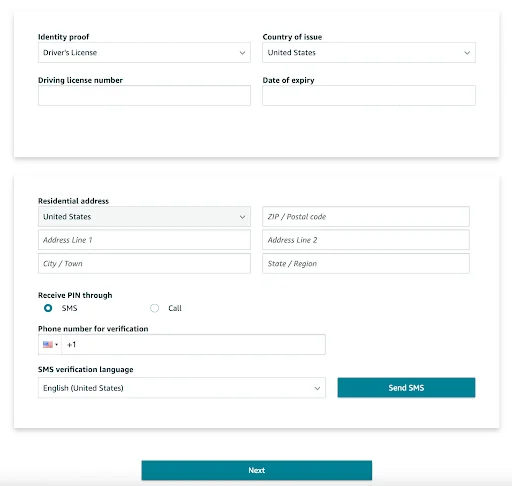
If you ever plan to transfer or update your seller account, understanding how to change ownership of Amazon seller account is just as important.
Step 2: Find Profitable Products on Alibaba
Choosing the right product is the key to success. Therefore, keep in mind the following tips when selecting products:
- Use tools like Helium 10 or Google Trends to analyze market demand.
- Avoid overly saturated markets.
- Ensure the cost of goods allows for a healthy profit after fees.
- Lighter, smaller products often incur lower shipping and storage fees.
- Ensure the product meets all regulatory requirements.
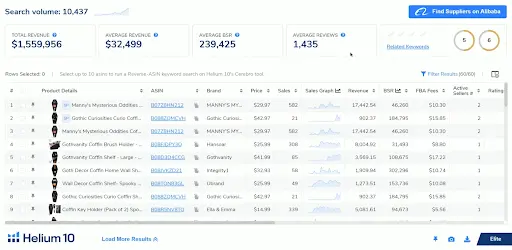
Step 3: Find a Reliable Supplier on Alibaba
Go to Alibaba and search for your product. However, remember to filter your search results to show “Verified Suppliers” or “Trade Assurance Suppliers”.
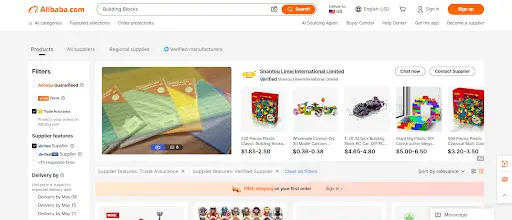
Why? Because, as a buyer, Trade Assurance is helpful to avoid scams and fraud. The Trade Assurance category is a brand of Alibaba in which suppliers pay a fee to join, which is used to fund the program and cover the costs.
Once you have multiple suppliers shortlisted, reach out to them to:
- Compare pricing & MOQs (Minimum Order Quantities)
- Inquire about customization (branding/packaging)
- Talk about timelines for shipping and certifications
Step 4: Order Product Samples
Ordering product samples is one of the most important steps; therefore, never skip it! Order samples from your shortlisted suppliers to:
- Test quality
- Check packaging
- Evaluate delivery time
- Inspect branding (if private labeling)
This ensures the product meets customer expectations and Amazon’s standards.

After verifying your samples, it is equally important to estimate fulfillment costs. This guide on Amazon FBA box size limits explains how packaging can affect your fees.
Step 5: Place a Bulk Order and Arrange Shipping
Once you have received a sample and are satisfied with it, negotiate pricing for a larger order.
- Choose a convenient shipping method: air freight for speed, sea freight for cost-effectiveness.
- Ensure products are labeled and packaged per Amazon’s requirements.
- Consider freight forwarders, as they can handle customs clearance and delivery to Amazon warehouses.
- Track and monitor the shipment to address any issues promptly.

To stay compliant with Amazon’s labeling standards during shipping, this guide on the Amazon FNSKU barcode explains everything you need to apply the correct product tags.
Step 6: Prepare Products According to Amazon FBA Requirements
While the shipping options are important, preparing your products as per Amazon FBA requirements is more important. Therefore, ask your supplier to:
- Label each item with Amazon FNSKU barcodes
- Pack products according to Amazon’s packaging rules
- Use proper carton labeling for the FBA warehouse
Amazon may reject improperly prepared shipments, so get this right from the start.
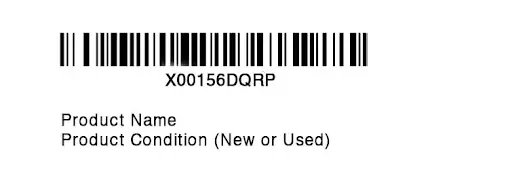
Step 7: Create and Optimize Your Product Listing
Once everything is sorted, it’s time to optimize your product listing. Go to your Amazon dashboard, click on “Add Products” from the left side menu, and list your product.
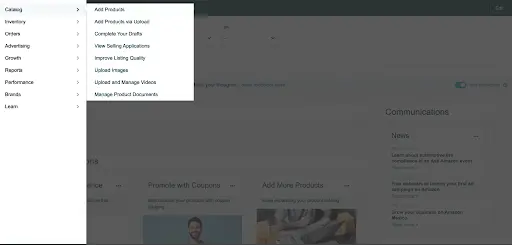
Include elements like:
- A keyword-rich title
- 5 bullet points highlighting key benefits
- A compelling product description
- High-resolution images (including lifestyle shots)
- Backend search terms for SEO
Remember, good listings = better rankings + higher conversions!

To further enhance your listing and build trust with shoppers, consider utilizing the Amazon Brand Story feature to showcase your brand identity.
Step 8: Set Pricing for Competitive Advantage
Pricing can make or break your success on Amazon. Here are effective strategies to help set your product prices:
- Competitive Pricing: Price the same or slightly lower than competitors, but keep the margin.
- Value-Based Pricing: Base the price on perceived value rather than cost.
- Tools for Dynamic Pricing: Use automated repricers to adjust your prices.
- Bundling Products: Offer items as a bundle for added value.
When setting prices, it’s essential to factor in advertising expenses. This breakdown of Amazon advertising costs in 2025 helps you plan smarter margins.

Step 9: Launch and Promote Your Product
Use Amazon PPC (Pay-Per-Click) ads to get your product in front of buyers. Consider:
- Offering coupons or launch discounts
- Running promotions with influencers
- Encouraging early reviews through Amazon’s Vine Program (if eligible)
- Run sponsored ads for targeted exposure.
- Promote your listings on platforms like Instagram and TikTok.
Step 10: Manage Inventory and Track Performance
Efficient inventory management prevents stockouts and overstocking.
- Leverage Amazon tools or third-party software to track inventory.
- Determine the minimum quantity before reordering.
- Monitor the sales trends because seasonal changes and promotions can impact inventory needs.
- Use Seller Central reports to review traffic, conversions, and sales data.
- Try different images, titles, or descriptions to see what performs best.
- Adjust PPC campaigns based on ROAS.
- Monitor customer feedback to identify product or service issues.
Data-driven strategies help optimize your listings and improve profitability.
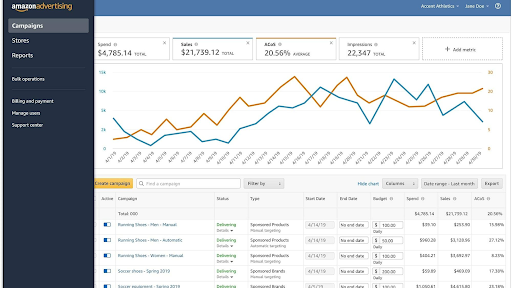
Understanding the Alibaba-Amazon Business Model
The Alibaba-Amazon business model is an effective and lucrative approach to buy products at wholesale prices on Alibaba and then resell them at retail prices on Amazon.
It basically takes advantage of the price difference between those two markets!
And with Fulfillment by Amazon (FBA), managing your inventory is a breeze. Your only job is shipping from Alibaba to Amazon FBA, and they handle the rest. This includes storage, shipping, and even customer service for you. It’s a brilliant way to free up your business and do more of what you love!
And once you’ve got the basics down, you may also want to review our breakdown of Amazon FBA box size limits for sellers to avoid shipping issues later.
Why Buy from Alibaba and Sell on Amazon?
Alibaba is the global B2B marketplace designed to connect sellers with trusted manufacturers and suppliers worldwide. Whether you’re a beginner or an expert, Alibaba arms you with the tools you need to source products effectively and with confidence.
Here’s why so many businesses choose Alibaba:
Endless Product Choices
From electronics to beauty products to home goods, you’ll find millions of items in nearly every category. Whatever you are trying to sell, it is probably there already.
Competitive Wholesale Prices
Save money and increase your profits. With bulk pricing and direct access to suppliers, you’re getting serious bang for your buck.
Customization Made Easy
Want your own logo or packaging? Most suppliers provide private labeling and customization, so you can create a brand that feels uniquely yours.
Secure Transactions You Can Trust
Worried about safety? With Alibaba’s Trade Assurance, your orders are protected, and the Verified Suppliers are filtered, so you know who to deal with. The main purpose is to protect your business.

If you’re sourcing from Alibaba but want to avoid handling inventory yourself, this guide on how to sell on Amazon without inventory walks you through your best options.
Common Challenges Faced When Selling Alibaba products on Amazon
Here are some common challenges with the solutions while selling Alibaba products on Amazon:
| Challenge | Solution |
| Shipping Delays | Use reliable freight forwarders when tracking your shipment |
| Poor Product Quality | Order sample products and inspect them properly |
| Supplier Miscommunication | Use clear records and record agreements |
| Competition Undercutting | Focus on branding and USPs |
| Account Suspension | Follow Amazon’s guidelines |
How to Scale Your Business for Growth?
So, you have set up your Amazon store and are successfully selling Alibaba products on Amazon. But it doesn’t stop here; consider ways to scale up:
Introduce New and Complementary Products
Expanding your product line is a smart way to grow revenue and deepen your presence within a niche. Since you’re already sourcing from Alibaba:
- Use Supplier Networks: Many Alibaba suppliers offer a wide variety of products. Ask your current suppliers about related items or trending additions in your niche.
- Product Bundles: Combine related products, such as a phone stand with a phone holder, to boost sales and reduce competition.
- Data-Driven Research: Use Amazon analytics tools like Helium 10 to identify related products with high search volumes and low competition.
Private Label and Build a Strong Brand
Creating a unique brand identity helps you stand out and encourages repeat purchases. Here’s how:
- Create Custom Packaging: Work with your Alibaba supplier to design packaging that showcases your logo, colors, and message.
- Trademark Your Brand: Protect your brand by registering it and joining Amazon Brand Registry.
- Build a Brand Story: On your Amazon storefront, share the story behind your products and why customers should trust your brand.
Streamline Supply Chain and Logistics
As your business grows, managing inventory gets more complicated. Here’s how to make it easier and more efficient:
- Bulk Ordering: Order more products from Alibaba suppliers to get better prices and terms.
- Third-Party Logistics (3PL): Consider using a 3PL provider to store and prep inventory before it goes to Amazon’s FBA warehouses.
- Direct-to-FBA Shipping: Work with suppliers who can ship directly to Amazon to reduce time and handling costs.
Hire Help
As your business grows, managing everything alone becomes unsustainable. Delegating routine tasks allows you to focus on strategy and scaling. You can hire:
- Virtual Assistants (VAs): For product research, customer service, inventory tracking, or managing feedback.
- Freelancers or Agencies: To create optimized listings, manage social media, or handle accounting.
- Amazon PPC Experts: Running ads effectively is crucial to growth, but it’s complex. Therefore, for Amazon advertising, consider working with a professional PPC agency like Impact Wolves.
Conclusion
If done correctly, Amazon stores selling Alibaba products can become a scalable and profitable business. If you follow the steps in this guide on how to sell Alibaba products on Amazon, from product search to marketing and scaling, you likely will be successful in the long term.
So take your time, do your research, and remember: a consistent brand and happy customers are the backbone of success in the e-commerce industry.
And, if you ever find yourself stuck in the experience, you can always reach out to Impact Wolves to navigate and inspire your e-commerce journey.



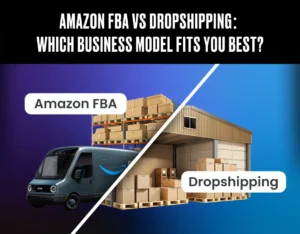
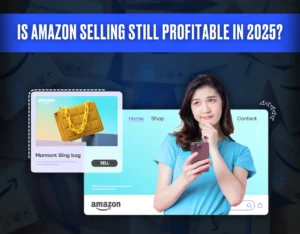

One Response